We may receive a commission when you use our affiliate links. However, this does not impact our recommendations.
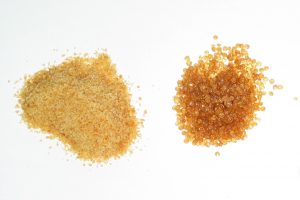
Most hide glue is sold in granular or pearl form.
Most hide glue is sold as a solid in granular or pearl form. To prepare hide glue for use, estimate how much solid glue you can use up in a few days to a week or more (it’s myth that you need to throw out the glue at the end of each day), and soak it in water for 20 minutes to a few hours depending on the particle size. The larger the particles the more time they will need to become fully saturated (mushy).
The glue comes in various gram strengths. The higher the gram strength the stronger the glue, but the faster it sets up. So there’s a trade-off. I’ve used 192 gram-strength glue for decades and find it plenty strong and easy to work with. Most musical-instrument makers and repairers use 251 gram strength, or even higher. But they are usually working on smaller objects.
For 192 gram-strength glue, use a ratio of about 2-2/3 cups of water to one pound of glue. (For your first batch I suggest you use 1/4 lb. of glue and 2/3 cup water so you don’t waste too much glue.) Higher gram strengths will require more water. You can always thin the glue later by adding more water or thicken it by adding more pre-soaked glue or by cooking off some of the water.
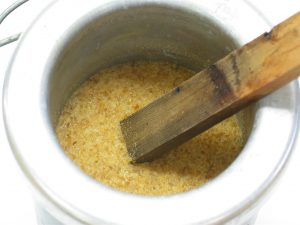
To prepare the glue, soak it in water until it becomes saturated.
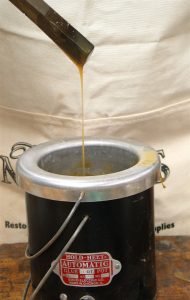
For most projects the viscosity of the glue should be about that of yellow glue. You can easily control it by adding water or more saturated glue, or by cooking off some of the water.
After adding the solid glue to water, stir for 10 or 20 seconds to prevent the glue from lumping at the bottom of the container. When all the glue has swollen with water, heat it to at least 130° Fahrenheit, but don’t let it boil. This should turn the glue into a liquid about the thickness of yellow glue. The glue will remain in a usable liquid condition as long as you keep it above 130° F (the ideal being 140° F to 150° F). When the glue cools to about 95° F, it gels, and you will have to reheat it to use it.
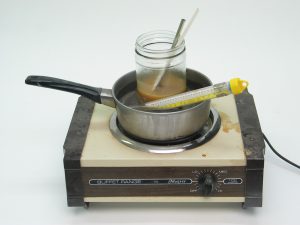
Instead of a glue pot you can put a jar of glue in hot water and keep it hot on a stove or electric hotplate.
You can buy a special electric glue pot from many woodworking suppliers to heat the glue. Or you can simply put a small pot or jar containing the glue into a larger pot of hot water, which you can keep hot on a stove or electric hotplate. (Remember, our woodworking ancestors didn’t have electricity, and they got along fine.)
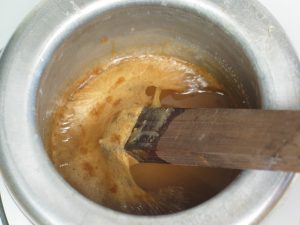
After turning on the heat a skin will form due to contact with cooler air. It’s good practice to remove this skin because it might contain dirt or other foreign matter.
After a short time, a skin will form on the surface of the glue due to contact with the cooler air. The first time you heat the glue this skin may contain some dirt or other foreign matter. The skin will usually appear slightly lighter in color than the glue underneath. It’s good practice, but not absolutely necessary, to remove this skin using a stick or brush, and throw it away.
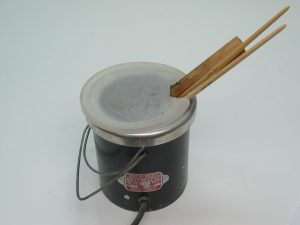
A good method for slowing evaporation is to cover the glue pot with a plastic coffee-can lid with a cutout for brushes and stirring sticks.
From then on, you can stir the skin back into the glue if more forms. Redissolving skin won’t weaken the glue. But the glue will become thicker due to water evaporation, and you’ll eventually need to add more water. It’s good practice to hold the moisture in and prevent the skin from forming by keeping the container covered when you’re not using the glue. A plastic coffee-can lid, with a cutout for protruding brushes, works well as a cover. You can keep the glue hot all day long if you want, or you can reheat it as you need it.
Hide glue often smells like rotten meat when it is heated. Many people find this odor offensive and thus don’t use the glue. The odor is caused by bacteria that wasn’t adequately removed at the factory where the glue was made. The sole remaining American hide-glue factory, Milligan & Higgins, takes extra care to clean the glue, and it thus has relatively little odor. Distributors for Milligan & Higgins include: Woodworker’s Supply, Merit Industries, Tools for Working Wood and many musical instrument suppliers.
So if the smell of the glue you are using bothers you, switch to hide glue from Milligan & Higgins. If you can buy in quantities of 50 pounds or more (possibly by dividing the glue with some friends), you can buy directly from the factory: milligan1868.com.
An alternative way of dealing with the bad smell is to mask the odor by adding one or two drops of wintergreen oil or citronella oil.
Here are some supplies and tools we find essential in our everyday work around the shop. We may receive a commission from sales referred by our links; however, we have carefully selected these products for their usefulness and quality.










Thanks for the informative article. Any suggestions for making fresh hide glue work in an unheated shop?
This time of year my options seem to be to get everything glued up and put together in 30 seconds (literally), or stack the boards up and wait until June. Even bottled liquid hide glue fails. I tried gluing up a panel with Old Brown Glue in 40 degree F but it gelled before I could mate the boards together. Fresh made pearls give even less working time. Is there some trick I don’t know?
Yellow glue seems to work in a cold shop and maybe that’s my only option. I like the way hide glue works, I just can’t seem to do it in cold weather.
Thanks again, I always enjoy your posts.
-K
MR. Flexner:
Your article on hide glues was well done! I’ve worked with hide glue for over 40 years building and restoring furniture. I noticed near the end of the article you mentioned the sometimes smell that you can get and I’d like to add some information.
1. Hide glue in gradual form is protein from animal hide only and has a very mild aroma. My dogs love it!
2. Hide glue in pearl form is protein from hides and bone. This glue has a very strong dead meat smell and aside from smelling bad has slightly different working characteristics.
3. Over heating any hide glue will result in stronger smells. In my experience anything over 140 degrees F will both cause a stronger smell and will make the working characteristics change.
I hope this information will help your readers as they try out and use the very best adhesive ever invented, hide glue!
Cjstruthers